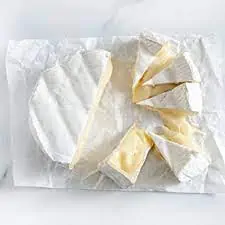Turophile is the official term used to describe a cheese lover. If you’re one, we bet you’re already familiar with this French classic, camembert. This soft cow’s milk cheese is the perfect accompaniment to fruits, nuts, and even meats!
But, if you’ve never tried it and wonder what camembert cheese tastes like, this article is for you!
Camembert cheese has a strong, nutty, and earthy taste profile with a silky texture. However, some also describe the undertones as eggy, garlicky, and even mushroomy! Although pungent, this cheese has several toothsome qualities that make you want to reach out for it, despite its hefty price tag!
Before you wrinkle your nose at the thought of this pate, let’s find out more about its texture, flavor, and substitutes!
What Does Camembert Cheese Taste Like?
Camembert is a cheese worth adding to your repertoire for its rich and creamy taste. It’s quite a flavorsome pate that goes well with all kinds of snacks, from fruits to nuts to jams and even meats!
Indulging in this deliciously-pungent cheese, you may even notice some unique flavor notes like fruity, milky, eggy, and grassy! In addition, the cheese’s tart goodness helps to subdue the creaminess and gives you the feel of eating curd.
Certain cheese varieties are known for their funky and sour aromas, and this is one of them. While ripened camembert is great at wooing cheese lovers, some individuals complain of weird notes, such as those of garlic and cabbage! As unusual as it sounds, camembert sure has pronounced smell notes that are unlike your typical varieties of cheese. Luckily, the overall flavor isn’t as intense as the aroma; however, it sure is slightly earthy and mushroom-like.
Altogether, the cheese’s exact taste and aroma depend on the type of milk and the length of the aging process. But, generally, camembert cheese is known to have an intense flavor with nutty-buttery and earthy notes. You may even notice a subtle taste of mushrooms. Texture-wise, it is velvety-soft but without being runny or drippy. As you break apart a chunk of this cheese, you get gelatinous and gooey bits of milky yet tart goodness!
You may notice taste and texture differences with fresh and aged camembert cheese. Most people opt for aged camembert cheese as it has more pronounced nutty and buttery notes when compared to fresh camembert. Furthermore, appearance-wise, the unripened version of this cheese usually comes with a yellow rind and a light, whitish interior. After aging, it develops an almost white mold while the inside turns ivory. According to cheese experts, the moldy rind on the cheese is edible; but if you don’t enjoy the rind, you may skip to the good part.
As with any cheese, camembert is a good source of healthy fats. Traditionally, the cheese is made with a combination of goat, sheep, and buffalo milk, making it a rich source of protein, calcium, and phosphorous. You also get to reap the benefits of its wide range of vitamins!
One advantage camembert has over other cheese is its high acidity, which makes it less perishable as bacteria is less likely to grow on it.
Eventually, it’s up to you to decide what this cheese tastes like to you. If you’re all for funky, pungent, and sharp-tasting cheeses, we recommend trying camembert. It’s the perfect creamy pate to have on your next cheese board!
Does Camembert Cheese Taste Like Brie?
Made from cow’s milk, camembert and brie have a soft, gooey texture. However, while the latter is a bit runny, the former is slightly denser. Taste-wise, most people find brie as having a milder flavor, whereas camembert tends to be more intense but with earthy notes.
Most people confuse camembert and brie because of their similarities; in fact, they’re often used interchangeably.
Besides having the same country of origin (Northern France), the cheeses also share an almost identical make-up. This is because cheesemakers use similar techniques to produce the two kinds of cheese.
The only difference between the two is that brie has a higher milk fat concentration, which is responsible for the rich and creamy mouthfeel.
Does Camembert Cheese Taste Like Blue Cheese?
Anyone who has had both can tell you that camembert cheese and blue cheese are poles apart. As described earlier, camembert has a creamy-buttery texture due to the higher fat percentage. Blue cheese, on the other hand, is somewhat soft and crumbly.
Moreover, since Roquefort or blue cheese is made from sheep’s milk, it has an entirely different flavor profile.
Additionally, after curing, the curd is added to the mixture before the final pressing, which results in a pungent and sharp flavor. Some even describe it as slightly spicy, salty, and even tangy. The only similarity between the two types of cheese is their pungent and sharp aromas!
Does Camembert Cheese Taste Like Cheddar?
No. While camembert is a rich, creamy pate, cheddar, on the other hand, is a hard cheese. Moreover, in terms of flavor profile, camembert and cheddar aren’t identical – not all cheeses are created equal!
Since they’re different in their taste, texture, and make-up, it’s not fair to compare the two. So the only way to pick a winner is to judge according to preference.
Cheddar is a decent snack; it also goes well as melted cheese dips. On the contrary, camembert is a strong-tasting cheese, having French origins. Its creamy and runny texture is usually compared to brie.
Most camembert lovers prefer having the pate as a cold sauce or over flatbreads, pizza, or sandwiches.
Conclusion
Camembert cheese is truly an experience that’s not easily forgotten. The flavor power of this pate can turn baked goodies from ordinary to extraordinary with just a few slices or chunks! With its rich and velvety taste, camembert is usually a top favorite among cheese lovers!
Keep in mind; that it’s a strong-tasting cheese. Therefore, it may take some getting used to, but once you get the hang of the flavor, you wouldn’t be able to do without it!
If intense flavors are more of your thing, then you’ll find this cheese a delectable option. But, if not, then it’s better to stick with some good old cheddar!

